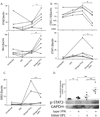Oligomeric procyanidins stimulate innate antiviral immunity in dengue virus infected human PBMCs
- PMID: 21371507
- PMCID: PMC3076897
- DOI: 10.1016/j.antiviral.2011.02.011
Oligomeric procyanidins stimulate innate antiviral immunity in dengue virus infected human PBMCs
Abstract
Oligomeric procyanidins (OPCs) have been shown to have antiviral and immunostimulatory effects. OPCs isolated from non-ripe apple peel were tested for capacity to reduce dengue virus (DENV) titers. Similar to published accounts, OPCs exhibited direct antiviral activity. The possibility of enhanced innate immune protection was also tested by measuring and characterizing gene and protein expression induced by OPCs during DENV infection. Treatment of DENV-infected human PBMCs with OPCs decreased viral titers and affected the expression of critical innate antiviral immune products. OPCs enhanced expression of MXI and IFNB transcripts in high MOI DENV infected PBMC cultures, and phosphorylation of STAT2 in response to recombinant type I IFN (IFN I). During low MOI infection, addition of OPCs increased expression of STAT1 transcripts, MHC I and TNFα protein production. Thus, OPCs exhibited innate immune stimulation of cells in DENV-infected cultures and uninfected cells treated with IFN I. While OPCs from a number of sources are known to exhibit antiviral effects, their mechanisms are not precisely defined. The capacity of OPCs to increase sensitivity to IFN I could be broadly applicable to many viral infections and two separate antiviral mechanisms suggest that OPCs may represent a novel, robust antiviral therapy.
Copyright © 2011 Elsevier B.V. All rights reserved.
Figures





Similar articles
-
Salidroside exhibits anti-dengue virus activity by upregulating host innate immune factors.Arch Virol. 2016 Dec;161(12):3331-3344. doi: 10.1007/s00705-016-3034-1. Epub 2016 Aug 31. Arch Virol. 2016. PMID: 27581807
-
Innate immunity to dengue virus infection and subversion of antiviral responses.J Mol Biol. 2014 Mar 20;426(6):1148-60. doi: 10.1016/j.jmb.2013.11.023. Epub 2013 Dec 3. J Mol Biol. 2014. PMID: 24316047 Free PMC article. Review.
-
How Dengue Virus Circumvents Innate Immunity.Front Immunol. 2018 Dec 4;9:2860. doi: 10.3389/fimmu.2018.02860. eCollection 2018. Front Immunol. 2018. PMID: 30564245 Free PMC article. Review.
-
Human keratinocyte cultures (HaCaT) can be infected by DENV, triggering innate immune responses that include IFNλ and LL37.Immunobiology. 2018 Nov;223(11):608-617. doi: 10.1016/j.imbio.2018.07.006. Epub 2018 Jul 6. Immunobiology. 2018. PMID: 30007822
-
Suppression of chikungunya virus replication and differential innate responses of human peripheral blood mononuclear cells during co-infection with dengue virus.PLoS Negl Trop Dis. 2017 Jun 23;11(6):e0005712. doi: 10.1371/journal.pntd.0005712. eCollection 2017 Jun. PLoS Negl Trop Dis. 2017. PMID: 28644900 Free PMC article.
Cited by
-
Tackling the Future Pandemics: Broad-Spectrum Antiviral Agents (BSAAs) Based on A-Type Proanthocyanidins.Molecules. 2022 Nov 30;27(23):8353. doi: 10.3390/molecules27238353. Molecules. 2022. PMID: 36500445 Free PMC article. Review.
-
GSPE Protects against Bleomycin-Induced Pulmonary Fibrosis in Mice via Ameliorating Epithelial Apoptosis through Inhibition of Oxidative Stress.Oxid Med Cell Longev. 2022 Mar 20;2022:8200189. doi: 10.1155/2022/8200189. eCollection 2022. Oxid Med Cell Longev. 2022. PMID: 35355866 Free PMC article.
-
Procyanidins: a comprehensive review encompassing structure elucidation via mass spectrometry.Phytochem Rev. 2018 Feb;17(1):1-16. doi: 10.1007/s11101-017-9507-3. Epub 2017 May 9. Phytochem Rev. 2018. PMID: 29651231 Free PMC article.
-
Monomeric catechin and dimeric procyanidin B2 against human norovirus surrogates and their physicochemical interactions.Food Microbiol. 2018 Dec;76:346-353. doi: 10.1016/j.fm.2018.06.009. Epub 2018 Jun 21. Food Microbiol. 2018. PMID: 30166160 Free PMC article.
-
Computational screening of known broad-spectrum antiviral small organic molecules for potential influenza HA stem inhibitors.PLoS One. 2018 Sep 4;13(9):e0203148. doi: 10.1371/journal.pone.0203148. eCollection 2018. PLoS One. 2018. PMID: 30180218 Free PMC article.
References
-
- Charlton AJ, Baxter NJ, Khan ML, Moir AJ, Haslam E, Davies AP, Williamson MP. Polyphenol/peptide binding and precipitation. J Agric.Food Chem. 2002;50:1593–1601. - PubMed
-
- Chen JP, Lu HL, Lai SL, Campanella GS, Sung JM, Lu MY, Wu-Hsieh BA, Lin YL, Lane TE, Luster AD, Liao F. Dengue Virus Induces Expression of CXC Chemokine Ligand 10/IFN-{gamma}-Inducible Protein 10, Which Competitively Inhibits Viral Binding to Cell Surface Heparan Sulfate. J Immunol. 2006;177:3185–3192. - PubMed
-
- Chunhakan S, Butthep P, Yoksan S, Tangnararatchakit K, Chuansumrit A. Early diagnosis of dengue virus infection by detection of dengue viral antigen in peripheral blood mononuclear cell. Pediatr.Infect Dis J. 2009;28:1085–1088. - PubMed
Publication types
MeSH terms
Substances
Grants and funding
LinkOut - more resources
Full Text Sources
Research Materials
Miscellaneous

